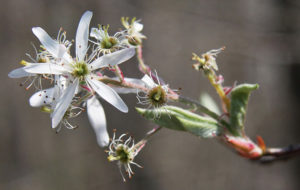
Spring brings forth images of life. But the serviceberry tree has its ties to the exact opposite.
It’s the tree in Central Pennsylvania that once served as a signal to let early settlers know it was warm enough to bury their dead.
Gerald L. Hoy, a service forester serving Mifflin, Union and Snyder counties with the Bureau of Forestry, Bald Eagle State Forest, said its many names is what makes the tree unique.
“In my experience, no PA native species has so many common names. The Pennsylvania pioneers used this tree’s early season blooms as a time indicator for several reasons,” said Hoy.
The tree’s original plant name is Amelanchier arborea.
Serviceberry is the second most well- known name for the tree.
“The European settlers used the blooming flowers in April to signal the ground has thawed enough to dig graves for their loved ones that died over the frozen winter. During this time they would have their graveside funeral services — Serviceberry,” Hoy said.
Harvey Reiff owns Reiff’s Nursery in Lewisburg. He has experienced customers who get confused over the names.
“Someone from another nursery called me for the Amelanchier tree. When he got here and I brought it out he said, ‘Well, that’s the serviceberry tree.’”
Other names, Hoy listed, include Juneberry, Sarviss berry, shad bush and shad blow.
The latter two names, Hoy explained, referenced shad, the herring-like fish that enters rivers from the sea to spawn.
“The blooming flowers coincided with the same time shad began to migrate up our streams and rivers. So the blooms from this tree indicated it was time to fish for shad,” Hoy said.
Juneberry is the name that most reflects the blooming of the tree.
“This tree is one of the earliest tree species to bear fruit … as early as June. The fruit comes in a small red berry that resembles a smaller bright red cherry. These are edible by people but are often hard to find due to the overwhelming number of birds and animals that also eat the fruit,” Hoy said.
Reiff said the tree was known as a “survival tree,” when settlers were lacking food and needed nourishment from the berries on the trees.
Sarviss berry, Hoy said, “is thought to be from sorbus, a latin taxonomic name for the related mountain ash tree.”
Reiff also described the tree as “hardy to Zone Four,” noting the Union, Snyder and Mifflin County area he serves is Zone Six and the tree would grow well in this environment. He said the tree grows 15-25 feet in height.
Hoy shared some insight about the tree’s growth from a document he prepared for the DCNR website: “In April, the serviceberry’s white blossoms can be easily seen from a distance on Pennsylvania mountain sides. A Serviceberry almost never grows in a grove of other Serviceberry trees. Instead, they stand as a single or small clump scattered sparsely throughout a forest. Even at maturity, they are a fairly small tree, rarely growing more than 12 inches in diameter and usually less than 40 feet in height.”
Reiff said this is a tree that is difficult to sell, although he said, he doesn’t know why.
“People ask about them, but they don’t buy them,” he said, and many customers enjoy looking at them in the spring time.


